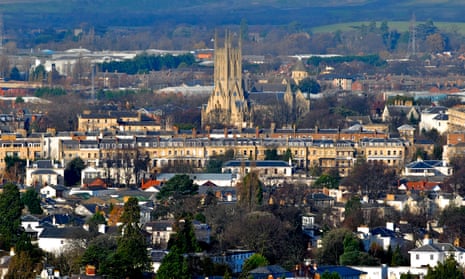In the Regency spa town of Cheltenham, famous for its mineral springs and horse racing festival, an angry rebellion is gathering steam.
At its centre is a stone fountain supported by three cherubs. The landmark used to be on a roundabout, with cars, buses and trucks swirling around both it and pedestrians trying to cross the high street. Several decades ago the road layout changed to create a tiny plaza around the fountain, which became known as Boots Corner. But heavy traffic still rumbled by.
Then, earlier this year the council took another step. It banned all vehicles, apart from buses and taxis, from the area in an effort to reduce congestion and pollution. It wanted, it said, to “put people before traffic”.
But rather than being grateful, the people – or many of them, at least – are furious. They have written letters to the local paper and complained to their MP, they have taken to social media, and a protest planned for Friday has been organised on Facebook by local rights activist and Deliveroo driver Rob Chandler, who says he and his colleagues have struggled to navigate the area since Boots Corner shut to general through-traffic in June.
According to the council, the pilot traffic scheme around Boots Corner has, within four months, resulted in a 206% increase in the number of cyclists, an 84% rise in pedestrian footfall and an 85% drop in the number of vehicles.
Opponents of the scheme claim it has merely forced vehicles into other streets, creating rat-runs and traffic jams, and has required people to make longer car journeys than before. The local MP, Alex Chalk, says he is “deluged with complaints about the misery it is causing” and has called for the scheme to be “reversed before more damage is done”.
The battle of Boots Corner is a quintessentially local issue – a council at odds with residents over changes to road layouts, with an undercurrent of party political tension between a Lib Dem-run authority and a Tory MP. But it is also emblematic of a national and international problem: how to reduce congestion and pollution in town and city centres, and create greener, cleaner and safer environments, while improving the efficiency with which people and goods move from A to B.
Almost all planners agree the key is persuading people to reduce car use – but that will require a massive change in culture and attitudes alongside tangible improvements to public transport. Some suggest the tension between individual liberty and social benefit is akin to the issue of banning smoking in public places. It is almost unfathomable now that 30 years ago people were permitted to smoke on planes and in cinemas; it may take another generation to change car culture, they say.
“More and more towns and cities are considering measures. The data on air quality is so compelling that people will start demanding it,” said James Cleeton of Sustrans, which campaigns to increase walking and cycling. “We understand people are reluctant to get out of their cars but there are massive positives to them as individuals and to society in general.”
Elsewhere in the UK, cities are taking a variety of approaches. Birmingham has turned areas of the city centre into pedestrian zones, and nearby Wolverhampton has unveiled similar plans. Edinburgh has announced monthly car-free days, and half of Glaswegians say they are in favour of following suit.
Nottingham has imposed a levy on workplace parking, with Oxford and Cambridge considering similar proposals. Bath and Bristol could become the first cities outside London to introduce a congestion charge on motorists. But at Boots Corner, opponents of the car ban intend to force the council into a U-turn.
“It’s a total failure,” said Chandler. “There is traffic chaos in the surrounding streets. The council needs to go back to the drawing board.” Chandler says his livelihood as a Deliveroo driver had been affected by the closure. “Essentially I can’t work in the centre of Cheltenham until after 6pm.”
Charlotte Blanch, headteacher at the Catholic School of St Gregory the Great, is concerned there will be an accident as a result of the pilot scheme diverting traffic near her school. It was “now like the M25”, she told a local news website.
Along the Promenade, the town’s beloved tree-lined shopping stretch leading to Boots Corner, those running food stalls were mostly scathing of the changes. “You can’t get from one end of town to another,” said Paul. According to Yara, the only beneficiary was the council, now fining motorists £60 for each transgression. “They talk about pollution and congestion but it’s hardly London, is it?”
Andrew McKinlay, a member of Cheltenham borough council’s cabinet, acknowledged there was “a body of public opinion opposed to the scheme” despite data showing a rise in pedestrians and cyclists. “Cheltenham has always had a vociferous minority who oppose change of any sort,” he said. “We’re just trying to improve the town centre.”
Gary Cawsey, who runs a coffee stall near the town hall, was sympathetic to the goals. “Should we remove traffic from town centres? Yes. But they haven’t done that, they’ve just moved it to other streets. The council isn’t being bold enough. They need to pedestrianise the whole centre.”

Comments (…)
Sign in or create your Guardian account to join the discussion